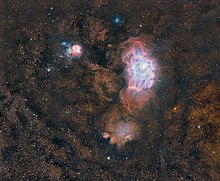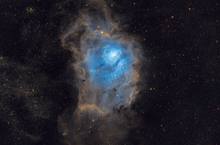

 18h03m37s, −24° 23′12″
18h03m37s, −24° 23′12″| Emission nebula | |
|---|---|
| H II region | |

M8, the Lagoon Nebula
| |
| Observation data: J2000 epoch | |
| Right ascension | 18h03m37s[1] |
| Declination | −24° 23′ 12″[1] |
| Distance | 4,100[2] ly (1,250 pc) |
| Apparent magnitude (V) | 4.6[3] |
| Apparent dimensions (V) | 90 × 40 arcmins[3] |
| Constellation | Sagittarius |
| Physical characteristics | |
| Radius | 55 × 20 ly |
| Designations | Sharpless 25, RCW 146, Gum 72 M8 contains: NGC 6523, NGC 6530,[1] Hourglass nebula[4] |
| See also: Lists of nebulae | |
The Lagoon Nebula (catalogued as Messier 8orM8, NGC 6523, Sharpless 25, RCW 146, and Gum 72) is a giant interstellar cloud in the constellation Sagittarius. It is classified as an emission nebula and has an H II region.
The Lagoon Nebula was discovered by Giovanni Hodierna before 1654[5] and is one of only two star-forming nebulae faintly visible to the eye from mid-northern latitudes. Seen with binoculars, it appears as a distinct cloud-like patch with a definite core. Within the nebula is the open cluster NGC 6530.[6]


The Lagoon Nebula is estimated to be between 4,000–6,000 light-years away from the Earth. In the sky of Earth, it spans 90' by 40', which translates to an actual dimension of 110 by 50 light years. Like many nebulae, it appears pink in time-exposure color photos but is gray to the eye peering through binoculars or a telescope, human vision having poor color sensitivity at low light levels. The nebula contains a number of Bok globules (dark, collapsing clouds of protostellar material), the most prominent of which have been catalogued by E. E. Barnard as B88, B89 and B296. It also includes a funnel-like or tornado-like structure caused by a hot O-type star that emanates ultraviolet light, heating and ionizing gases on the surface of the nebula. The Lagoon Nebula also contains at its centre a structure known as the Hourglass Nebula (so named by John Herschel), which should not be confused with the better known Engraved Hourglass Nebula in the constellation of Musca. In 2006, four Herbig–Haro objects were detected within the Hourglass, providing direct evidence of active star formation by accretion within it.[2]
{{cite web}}: CS1 maint: multiple names: authors list (link)
|
| ||
|---|---|---|
| List |
| |
| See also |
| |
| ||